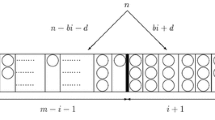Abstract
We present a randomized strategy for maintaining balance in dynamically changing search trees that has optimalexpected behavior. In particular, in the expected case a search or an update takes logarithmic time, with the update requiring fewer than two rotations. Moreover, the update time remains logarithmic, even if the cost of a rotation is taken to be proportional to the size of the rotated subtree. Finger searches and splits and joins can be performed in optimal expected time also. We show that these results continue to hold even if very little true randomness is available, i.e., if only a logarithmic number of truely random bits are available. Our approach generalizes naturally to weighted trees, where the expected time bounds for accesses and updates again match the worst-case time bounds of the best deterministic methods.
We also discuss ways of implementing our randomized strategy so that no explicit balance information is maintained. Our balancing strategy and our algorithms are exceedingly simple and should be fast in practice.
Similar content being viewed by others
References
G. M. Adel'son-Velskii and Y. M. Landis, An algorithm for the organization of information,Soviet Math. Dokl,3 (1962), 1259–1262.
A. Andersson and T. Ottmann, Faster uniquely represented dictionaries,Proc. 32nd FOCS, 1991, pp. 642–649.
H. Baumgarten, H. Jung, and K. Mehlhorn, Dynamic point location in general subdivision,Proc. 3rd ACM-SIAM Symp. on Discrete Algorithms (SODA), 1992, pp. 250–258.
R. Bayer and E. McCreight, Organization and maintenance of large ordered indices,Act. Inf.,1 (1972), 173–189.
S. W. Bent and J. R. Driscoll, Randomly balanced search trees, Manuscript (1991).
S. W. Bent, D. D. Sleator, and R. E. Tarjan, Biased search trees,SIAM J. Comput.,14 (1985), 545–568.
R. P. Brent, Fast multiple precision evaluation of elementary functions,J. Assoc. Comput. Mach.,23 (1976), 242–251.
M. Brown, Addendum to “A Storage Scheme for Height-Balanced Trees,”Inform. Process. Lett.,8 (1979), 154–156.
K. L. Clarkson, K. Mehlhorn, and R. Seidel, Four results on randomized incremental construction,Comput. Geom. Theory Appl.,3 (1993), 185–212.
L. Devroye, A note on the height of binary search trees,J. Assoc. Comput. Mach.,33 (1986), 489–498.
M. Dietzfelbinger (private communication).
I. Galperin and R. L. Rivest, Scapegoat trees,Proc. 4th ACM-SIAM Symp. on Discrete Algorithms (SODA), 1993, pp. 165–174.
L. J. Guibas and R. Sedgewick, A dichromatic framework for balanced trees,Proc. 19th FOCS, 1978, pp. 8–21.
T. Hagerup and C. Rüb, A guided tour of Chernoff bounds,Inform. Process. Lett.,33 (1989/90), 305–308.
K. Hoffman, K. Mehlhorn, P. Rosenstiehl, and R. E. Tarjan, Sorting Jordan sequences in linear time using level linked search trees,Inform. and Control,68 (1986), 170–184.
E. McCreight, Priority search trees,SIAM J. Comput.,14 (1985), 257–276.
K. Mehlhorn,Sorting and Searching, Springer-Verlag, Berlin, 1984.
K. Mehlhorn,Multi-Dimensional Searching and Computational Geometry, Springer-Verlag, Berlin, 1984.
K. Mehlhorn (private communication).
K. Mehlhorn and S. Näher, Algorithm design and software libraries: recent developments in the LEDA project, inAlgorithms, Software, Architectures, Information Processing 92, Vol. 1, Elsevier, Amsterdam, 1992.
K. Mehlhorn and S. Näher, LEDA, a platform for combinatorial and geometric computing.Commun. ACM,38 (1995), 95–102.
K. Mehlhorn and R. Raman (private communication).
K. Mulmuley,Computational Geometry: An Introduction through Randomized Algorithms, Prentice-Hall, Englewood Cliffs, NJ, 1994.
S. Näher, LEDA User Manual Version 3.0. Tech. Report MPI-I-93-109, Max-Planck-Institut für Informatik, Saarbrücken, 1993.
J. Nievergelt and E. M. Reingold, Binary search trees of bounded balance,SIAM J. Comput. 2 (1973), 33–43.
W. Pugh, Skip lists: a probabilistic alternative to balanced trees.Commun. ACM,33 (1990), 668–676.
W. Pugh and T. Teitelbaum, Incremental computation via function caching,Proc. 16th ACM POPL, 1989, pp. 315–328.
D. D. Sleator (private communication).
D. D. Sleator and R. E. Tarjan, Self-adjusting binary search trees,J. Assoc. Comput. Mach.,32 (1985), 652–686.
R. E. Tarjan (private communication).
J. Vuillemin, A unifying look at data structures,Comm. ACM,23 (1980), 229–239.
Author information
Authors and Affiliations
Additional information
Communicated by M. Luby.
This paper is dedicated to the memory of Gene Lawler.
Supported by NSF Presidential Young Investigator award CCR-9058440.
Supported by an AT&T graduate fellowship.
Rights and permissions
About this article
Cite this article
Seidel, R., Aragon, C.R. Randomized search trees. Algorithmica 16, 464–497 (1996). https://doi.org/10.1007/BF01940876
Received:
Revised:
Issue Date:
DOI: https://doi.org/10.1007/BF01940876




